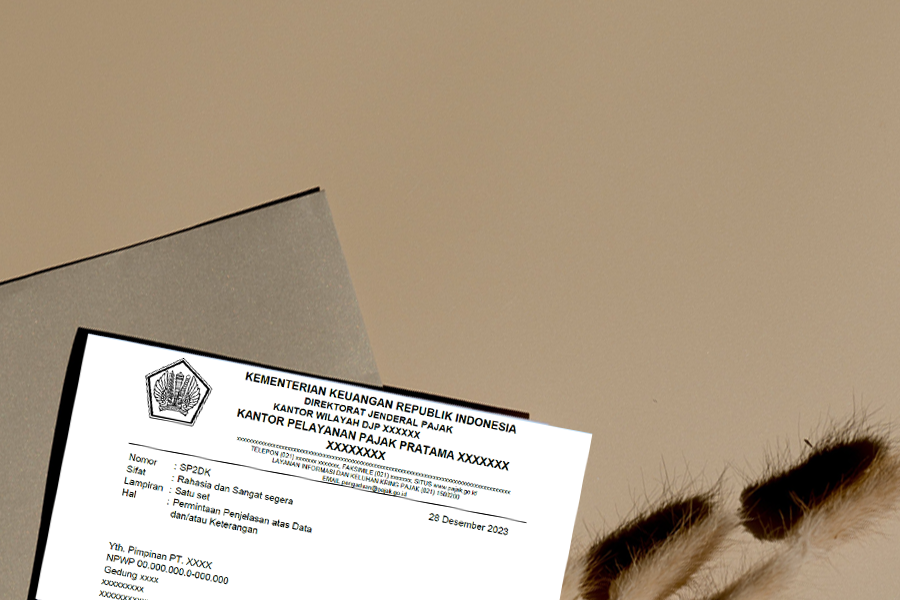Soal SP2DK: Fahami Dulu Prosedurnya, Sampaikan Respon Kemudian
Dwi Novianti Suharsih,

Keberadaan Surat Penjelasan atas Data dan/atau Keterangan (SP2DK) selama ini sering diidentikkan sebagai upaya otoritas pajak untuk menambah penerimaan pajak. Hal itu menimbulkan persepsi negatif di mata wajib pajak.
Bahkan, untuk mereduksi kesan negatif atas penerbitan SP2DK, pemerintah hendak melakukan penyesuaian redaksional dan tampilan SP2DK. Lantas, apa sebenarnya SP2DK dan respon seperti apa yang sebaiknya dilakukan wajib pajak ketika menerima SP2DK?
SP2DK adalah surat yang diterbitkan oleh Account Representative (AR) Kantor Pelayanan Pajak (KPP) dalam hal permintaan penjelasan data kepada wajib pajak. Selain bertugas memberikan pelayanan dan konsultasi kepada wajib pajak, peran AR juga kini diperluas karena harus bertanggung jawab dalam melakukan pengawasan.
Baca Juga: Peran Account Representative Pajak Diatur Ulang
Proses Penerbitan SP2DK
Adapun SP2DK diterbitkan karena adanya perbedaan data antara data yang dimiliki kantor pajak dengan data yang disampaikan wajib pajak. Bila diketahui keliru dalam memenuhi kewajibannya, wajib pajak dapat melakukan pembetulan SPT. Kemudian, wajib pajak juga dapat melakukan pembayaran, dalam hal terdapat objek pajak yang belum disetorkan.
Namun, untuk dapat memberikan respon yang tepat, sebaiknya wajib pajak memang memahami proses penerbitan SP2DK, berikut ini:
.png)
1. SP2DK Diterbitkan
Setelah meneribtkan SP2DK, DJP akan memberikan waktu kepada wajib pajak untuk menyampaikan tanggapannya, paling lambat 14 hari kalender sejak tanggal SP2DK.
Sebagai informasi, AR dapat menerbitkan SP2DK lebih dari satu kali dalam tahun yang sama. Sehingga, memungkinkan wajib pajak mendapatkan SP2DK kembali selama SP2DK belum ditutup/Berita Acara Pelaksanaan P2DK diterbitkan oleh Kantor Pajak.
2. Penyampaian Tanggapan Oleh WP
Penyampaian tanggapan dapat dilakukan secara tatap muka, menggunakan sarana audio visual (tidak secara langsung), atau tertulis. Penjelasan dapat disampaikan lebih dari satu kali apabila diperlukan.
3. Pelaksanaan Kunjungan
Apabila tidak memberikan penjelasan dalam waktu yang ditentukan, SP2DK dapat ditindaklanjuti dengan pelaksanaan kunjungan. Kunjungan ini dimaksudkan untuk validasi atas penjelasan yang diterima dari wajib pajak.
4. Pembahasan
Dalam hal penelitian atas penjelasan wajib pajak masih belum mendapatkan kesimpulan dan rekomendasi lebih lanjut, kepala KPP dapat menindaklanjuti dengan pelaksanaan pembahasan dengan mengundang wajib pajak.
5. Simpulan dan Rekomendasi
Berdasarkan hasil penelitian, Tim Peneliti akan memberikan simpulan dan rekomendasikan tindak lanjut.
Adapun tindak lanjut dapat berupa rekomendasi untuk tidak ditindaklanjuti, rekomendasi perubahan data dan administrasi perpajakan, pengusulan pemeriksaan, pengusulan pemeriksaan bukti permulaan, atau rekomendasi lainnya.
Respon Wajib Pajak
Ada beberapa hal yang perlu diperhatikan wajib pajak dalam merespon SP2DK yang diterima wajib pajak, berikut diantaranya:
1. Komunikasi dan Itikad Baik
Penting bagi wajib pajak untuk menujukkan itikad baik saat menerima SP2DK dari AR, diantaranya dengan menjaga komunikasi. Dua hal tersebut menjadi hal yang penting di samping materi penjelasan SP2DK.
2. Meminta Kertas Kerja SP2DK
Sebelum memberikan penjelasan, wajib pajak dapat meminta kertas kerja SP2DK ke kantor pajak. Dengan mengetahui kertas kerja, wajib pajak dapat menyusun analisis lebih lanjut, karena dapat melihat perbedaan data antara yang dimiliki wajib pajak dengan yang dimiliki AR.
3. Siapkan Penjelasan
Wajib pajak harus bisa menjelaskan perbedaan data antara yang disajikan AR dengan yang dimiliki wajib pajak. Pastikan penjelasan disampaikan tidak melebihi batas waktu yang ditentukan.
Jika penyusunan penjelasan tidak selesai hingga batas waktunya, wajib pajak bisa memberikan tanggapannya sebagian. Selanjutnya, wajib pajak bisa meminta tambahan waktu.
Penjelasan sebaiknya, disusun disertai landasan hukum, penjelasan detail transaksi, dan dokumen pendukung. Hal ini tentunya akan dapat menanggapi perbedaan data yang ada.
Objek Penelitian SP2DK
Sebaiknya, penjelasan atau data yang disampaikan wajib pajak, harus berkaitan dengan objek penelitian SP2DK. Berikut ini objek pajak yang seringkali muncul dalam SP2DK:
a. Peredaran Usaha
Peredaran usaha atau omzet sudah umum menjadi objek perbandingan dalam SP2DK. Biasanya, AR akan membandingkan peredaran usaha yang dilaporkan pada SPT PPh Badan dengan total Pajak Keluaran dalam Surat Pemberitahuan (SPT) Pajak Pertambahan Nilai (PPN).
b. Cost of Goods Sold/COGS
Unsur-unsur COGS tidak luput dari perhatian AR, dapat berupa angka pembelian, pengiriman, dan biaya-biaya lain yang di tampilkan pada SPT Pajak Penghasilan (PPh) Badan.
c. Operating and Selling Expenses
Unsur beban operasional dan beban penjualan seringkali dibandingkan dengan objek pada SPT PPh Pasal 21, PPh Pasal 23, PPh Pasal 26, dan PPh final. AR akan mengkonfirmasi kepatuhan pajak atas pengeluaran beban Perusahaan.
d. Others Income & Expenses
Hal yang cukup sering ditanyakan oleh AR berupa permintaan penjelasan nature transaksi dan dokumen pendukung. Apabila dalam akun tersebut terdapat objek PPh dan PPN, pastikan wajib pajak sudah melakukan pemotongan dan pemungutannya.
e. Transaksi dengan Pihak Afiliasi
Dalam hal ini, wajib pajak hendaknya menyiapkan kontrak dan dokumen lainnya untuk memastikan transaksi dengan pihak afiliasi sudah memenuhi ketentuan perpajakan.
Dalam konteks ini, SP2DK merupakan alat kontrol yang efektif untuk memastikan kepatuhan wajib pajak, dengan tetap berada dalam koridor sistem pemajakan kita yang berbasiskan self assessment. (ASP)


